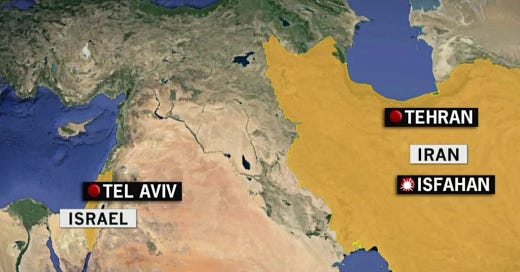Iran was minimizing suspected Israeli retaliation overnight, centered at an airbase near the Iranian city of Isfahan, leading some analysts to tentatively suggest that the two sides could choose to take an off-ramp from the threat of further direct confrontation for now. But that was not a certainty, they cautioned.
The precise details of what occurred were still unclear, but Iran said the sound of explosions some heard near the Isfahan airbase overnight were Iranian air defenses firing at unknown objects, initially described as small drones or quadcopters, that some Iranian reports indicated were launched from within Iran. Subsequent reports today (April 19) suggested that the suspected Israeli retaliation could have utilized both drones as well as Israeli F-16 fighter jets bombing radar sites in Syria, then proceeding over Iraq to fire missiles at targets inside Iran.
US Secretary of State Antony Blinken, meeting with Group of 7 foreign ministers in Capri, Italy, today, declined to say if the United States was notified in advance of the Israeli action, but stressed that the United States was not involved in any offensive action against Iran, and was seeking de-escalation.
His Italian host, Italian Foreign Minister Antonio Tajani, said that the United States was notified at the last minute of the planned Israeli action, but that the United States was not involved in what he described as a “small-scale event.”
“The U.S. were informed at the last minute, but there was no involvement on the part of the U.S.,” Tajani said in Capri, according to PBS. “I believe what has happened…the small-scale of the event, is also the results of the efforts of the G7.”
Iran experts noted initial signals from Iranian authorities that they were inclined to downplay the action overnight so as to avoid the need for further retaliation.
“By opting to respond in a limited manner, Israel has remained within the grey zone of covert operations, allowing Iran to absorb the attack without the need to retaliate and further escalate, while signalling to Tehran that its much larger overt plan failed to deter it,” Ali Vaez, Iran program director at the International Crisis Group, wrote.
“The most pressing question currently posed by experts in Iran is whether this was the entirety of Israel’s response, or just the beginning,” Iran expert Hamidreza Azizi, a visiting fellow at Berlin’s SWPBerlin think tank, wrote on Twitter.
Isfahan’s Eighth Fighter Base, which was reportedly a target of the Israeli action, hosts “SU-24 (bombers) and F-14 (fighters) that play a role in air-based defense of Iran’s nuclear facilities located in the province of Isfahan,” Azizi wrote. “For this reason, the warning is raised that if Israel’s target was these fighters, it could be a precursor to further actions in Isfahan, which in additional to nuclear facilities, also hosts Iranian military drone facilities.”
“In the most optimistic scenario, Israel’s aim was to send a serious warning about access within Iran,” Azizi wrote. “Also, to demonstrate that it does not accept Iran’s new red lines.”
“Given Iran’s official stance of downplaying this attack,…we should expect a return to the rules of engagement prior to the 1st of April,” when Israel struck an Iranian diplomatic compound in Damascus, Syria, killing seven senior Islamic Revolutionary Guard Corps (IRGC) officials, “and a return to the ‘shadow war.’”
“In the pessimistic scenario, Israel’s goal was either to test Iran’s defense systems or to disable the defense responsible for protecting strategic centers in Isfahan,” he wrote. “In this case, we should expect more—and possibly more widespread—attacks inside Iranian territory.”
(May update this post with further information today, available at the link.)
**



